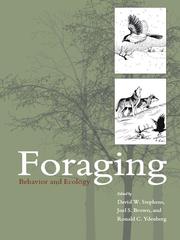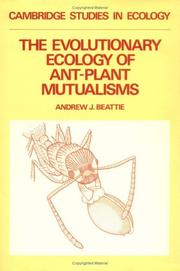| Listing 1 - 10 of 25 | << page >> |
Sort by
|
Book
ISBN: 9781402066658 9781402066665 Year: 2008 Publisher: Dordrecht Springer Science+Business Media B.V
Abstract | Keywords | Export | Availability | Bookmark
 Loading...
Loading...Choose an application
- Reference Manager
- EndNote
- RefWorks (Direct export to RefWorks)
Mosquito Ecology: Field Sampling Methods is the Third Edition of this popular reference work, originally devised and written by Professor M W Service and now updated by John B Silver. The purpose of the third edition is in keeping with the original vision of Professor Service to describe the methods and rationale for sampling mosquitoes, with particular emphasis on the ecology and behaviour of those species that play a role as vectors of human and animal diseases and infections. The book is designed to serve as a practical reference for field entomologists and mosquito control specialists and describes the sampling methods and available trapping technologies and tools for the collection of all life-stages of mosquitoes, from egg to adult. It also describes the techniques available for data analysis and discusses ecological principles of relevance to the study of field populations of mosquitoes. While concentrating primarily on mosquitoes, many of the techniques described are suitable for the study of other Diptera, including Ceratopogonidae, Chironomidae, Simuliidae, Phlebotominae, etc.
Culicidae --- Animal population --- life cycle --- Sampling --- trapping --- population dynamics --- Population distribution --- Foraging --- blood --- Vectors --- Epidemiology

ISBN: 0226772659 1281966568 9786611966560 9780226772653 9780226772639 0226772632 9780226772646 0226772640 9781281966568 6611966560 Year: 2007 Publisher: Chicago University of Chicago Press
Abstract | Keywords | Export | Availability | Bookmark
 Loading...
Loading...Choose an application
- Reference Manager
- EndNote
- RefWorks (Direct export to RefWorks)
Foraging is fundamental to animal survival and reproduction, yet it is much more than a simple matter of finding food; it is a biological imperative. Animals must find and consume resources to succeed, and they make extraordinary efforts to do so. For instance, pythons rarely eat, but when they do, their meals are large-as much as 60 percent larger than their own bodies. The snake's digestive system is normally dormant, but during digestion metabolic rates can increase fortyfold. A python digesting quietly on the forest floor has the metabolic rate of thoroughbred in a dead heat
Animals --- Animal diets --- Animal feeding behavior --- Animal food --- Animal food habits --- Animal foods --- Animals, Food habits of --- Feeding behavior in animals --- Food habits in animals --- Food of wild animals --- Foraging behavior in animals --- Animal behavior --- Food --- Food. --- Feeding behavior --- Food habits --- Foods --- Foraging behavior --- ecology, ecological, behavior, behavioral, evolution, evolutionary, biology, sciences, scientific, biological, imperative, foraging, foragers, cognitive science, anthropology, conservation, economics, neurobiology, technology, cognition, population, community, mammals, amphibians, food, eating, survival, neuroethology, energy storage, social interactions, diversity, dynamics, free distribution, provisioning, animals, wildlife.
Book
ISBN: 9781607814740 1607814749 9781607814733 1607814730 Year: 2016 Publisher: Salt Lake City
Abstract | Keywords | Export | Availability | Bookmark
 Loading...
Loading...Choose an application
- Reference Manager
- EndNote
- RefWorks (Direct export to RefWorks)
Indians of North America --- Hunting, Prehistoric --- American bison hunting --- Hunting, Primitive --- Hunting and foraging, Prehistoric --- Hunting and gathering, Prehistoric --- Prehistoric hunting --- Bison hunting --- Buffalo hunting --- Big game hunting --- Antiquities. --- History. --- Hunting.
Book
ISBN: 9783031062599 Year: 2022 Publisher: Cham Springer International Publishing :Imprint: Springer
Abstract | Keywords | Export | Availability | Bookmark
 Loading...
Loading...Choose an application
- Reference Manager
- EndNote
- RefWorks (Direct export to RefWorks)
Hunting and gathering societies. --- Hunting, Prehistoric --- Social aspects. --- Hunting, Primitive --- Hunting and foraging, Prehistoric --- Hunting and gathering, Prehistoric --- Prehistoric hunting --- Food gathering societies --- Gathering and hunting societies --- Hunter-gatherers --- Ethnology --- Subsistence hunting
Book
ISBN: 022633080X 9780226330808 9780226330778 022633077X Year: 2016 Publisher: Chicago London
Abstract | Keywords | Export | Availability | Bookmark
 Loading...
Loading...Choose an application
- Reference Manager
- EndNote
- RefWorks (Direct export to RefWorks)
At birdfeeders and in backyards across North America, the dark-eyed junco, or snowbird, can be found foraging for its next meal. With an estimated population of at least 630 million, juncos inhabit forests, parks, and even suburban habitats, making them one of the continent's most abundant and easily observable songbirds. But while common and widespread, juncos also exhibit extraordinary diversity in color, shape, size, and behavior across their range, making them ideal study subjects for biologists interested in ecology and evolutionary diversification. Intended for scholars, citizen scientists, and amateur ornithologists, alike, Snowbird synthesizes decades of research from the diverse and talented researchers who study the Junco genus. Though contributors approach their subject from a variety of perspectives, they share a common goal: elucidating the organismal and evolutionary processes by which animals adapt and diversify in response to environmental change. Placing special emphasis on the important role that underlying physiological, hormonal, and behavioral mechanisms play in these processes, Snowbird not only provides a definitive exploration of the junco's evolutionary history and behavioral and physiological diversity but also underscores the junco's continued importance as a model organism in a time of rapid global climate change. By merging often disparate biological fields, Snowbird offers biologists across disciplines an integrative framework for further research into adaptation, population divergence, and the formation of new species.
Juncos. --- biology, biological, evolution, evolutionary, diversity, junco, academic, scholarly, research, professor, college, university, naturalist, birds, bird watcher, foraging, forager, backyard, america, american, species, avian, birdfeeder, habitat, forest, suburban, songbird, common, behavior, animals, birding, ecology, adaptation, ornithology, ornithologist, genus, essay collection.

ISBN: 0897897366 0313011397 9780313011399 1280908408 9781280908408 9780897897365 9786610908400 6610908400 9798400667206 Year: 2002 Publisher: Westport, Conn. Bergin & Garvey
Abstract | Keywords | Export | Availability | Bookmark
 Loading...
Loading...Choose an application
- Reference Manager
- EndNote
- RefWorks (Direct export to RefWorks)
Prehistoric peoples --- Hunting, Prehistoric. --- Agriculture, Prehistoric. --- Hunting and gathering societies. --- Diet --- Homme préhistorique --- Chasse préhistorique --- Agriculture préhistorique --- Chasseurs-cueilleurs --- Alimentation --- Food. --- History. --- Histoire --- Health --- Food --- Food habits --- Nutrition --- Food gathering societies --- Gathering and hunting societies --- Hunter-gatherers --- Hunting, Primitive --- Ethnology --- Subsistence hunting --- Prehistoric agriculture --- Hunting and foraging, Prehistoric --- Hunting and gathering, Prehistoric --- Prehistoric hunting --- Agriculture, Prehistoric --- Agriculture --- Primitive societies
Book
ISBN: 0226923088 9780226923086 9781299619401 1299619401 9780226442495 0226442497 Year: 2013 Publisher: Chicago ; : London :. The University of Chicago Press,
Abstract | Keywords | Export | Availability | Bookmark
 Loading...
Loading...Choose an application
- Reference Manager
- EndNote
- RefWorks (Direct export to RefWorks)
The Biology of Sharks and Rays is a comprehensive resource on the biological and physiological characteristics of the cartilaginous fishes: sharks, rays, and chimaeras. In sixteen chapters, organized by theme, A. Peter Klimley covers a broad spectrum of topics, including taxonomy, morphology, ecology, and physiology. For example, he explains the body design of sharks and why the ridged, toothlike denticles that cover their entire bodies are present on only part of the rays' bodies and are absent from those of chimaeras. Another chapter explores the anatomy of the jaws and the role of the muscles and teeth in jaw extension, seizure, and handling of prey. The chapters are richly illustrated with pictures of sharks, diagrams of sensory organs, drawings of the body postures of sharks during threat and reproductive displays, and maps showing the extent of the species' foraging range and long-distance migrations. Each chapter commences with an anecdote from the author about his own personal experience with the topic, followed by thought-provoking questions and a list of recommended readings in the scientific literature. The book will be a useful textbook for advanced ichthyology students as well as an encyclopedic source for those seeking a greater understanding of these fascinating creatures.
Sharks --- Rays (Fishes) --- Rajiformes --- Anatomy. --- Behavior. --- biological, science, scientific, marine, aquatic, academic, scholarly, classroom, college, university, higher ed, educational, textbook, research, predators, conservation, wildlife, fish, physiology, physiological, traits, characteristics, cartilaginous, chimaera, taxonomy, morphology, ecology, denticles, teeth, prey, diagram, photos, organs, reproduction, foraging, migration, species, encyclopedia, anatomy.
Book
ISBN: 9781501740466 9781501740459 1501740458 1501740466 9781501740442 150174044X Year: 2020 Publisher: Ithaca, NY
Abstract | Keywords | Export | Availability | Bookmark
 Loading...
Loading...Choose an application
- Reference Manager
- EndNote
- RefWorks (Direct export to RefWorks)
"In this field guide to the future, esteemed Harvard University botanist Peter Del Tredici unveils the plants that will become even more dominant in urban environments under projected future environmental conditions. These plants are the most important and most common plants in cities. Learning what they are and the role they play, he writes, will help us all make cities more livable and enjoyable. With more than 1000 photos, readers can easily identify these powerful plants. Learn about the fascinating cultural history of each plant."--
Weeds --- Urban plants --- City plants --- Urban flora --- Urban vegetation --- Urban wildlife --- Plants --- Pest plants --- Weed plants --- Weedy plants --- Plant pests (Plants) --- Agricultural pests --- Botany, Economic --- edible wild plants, foraging. --- urban ecology, climate change, globalization, urbanization, weeds, invasive species, ecosystem services, phytoremediation.
Book
ISBN: 1282896040 9786612896040 0520947967 9780520947962 9781282896048 9780520266407 0520266404 Year: 2010 Publisher: Berkeley University of California Press
Abstract | Keywords | Export | Availability | Bookmark
 Loading...
Loading...Choose an application
- Reference Manager
- EndNote
- RefWorks (Direct export to RefWorks)
Shorebirds are model organisms for illustrating the principles of ecology and excellent subjects for research. Their mating systems are as diverse as any avian group, their migrations push the limits of endurance, and their foraging is easily studied in the open habitats of estuaries and freshwater wetlands. This comprehensive text explores the ecology, conservation, and management of these fascinating birds. Beginning chapters examine phylogenetic relationships between shorebirds and other birds, and cover shorebird morphology, anatomy, and physiology. A section on breeding biology looks in detail at their reproductive biology. Because shorebirds spend much of their time away from breeding areas, a substantial section on non-breeding biology covers migration, foraging ecology, and social behavior. The text also covers shorebird demography, population size, and management issues related to habitat, predators, and human disturbances. Throughout, it emphasizes applying scientific knowledge to the conservation of shorebird populations, many of which are unfortunately in decline.
Shore birds --- Birds --- Conservation. --- animal population. --- animals. --- avian group. --- avian. --- biology. --- birds. --- breeding areas. --- breeding biology. --- breeding. --- conservation. --- earth sciences. --- ecology. --- environment. --- environmentalism. --- estuaries. --- foraging. --- freshwater. --- habitat. --- life sciences. --- migration. --- nature. --- nonfiction. --- ornithology. --- predators. --- reproductive biology. --- science. --- shorebirds. --- social behavior. --- wetlands. --- wildlife. --- zoology.

ISBN: 0521252814 0521272726 9780521252812 9780511721878 9780521272728 Year: 1985 Publisher: London Cambridge University Press
Abstract | Keywords | Export | Availability | Bookmark
 Loading...
Loading...Choose an application
- Reference Manager
- EndNote
- RefWorks (Direct export to RefWorks)
General biophysics --- Insects. Springtails --- General ecology and biosociology --- Ants --- Botany --- Insect-plant relationships --- Insects --- Plants --- Fourmis --- Botanique --- Relations insecte-plante --- Insectes --- Plantes --- Ecology --- Evolution --- Ecologie --- Plant ecology --- Formicidae --- Insecte utile --- Useful insects --- Recherche de nourriture --- Foraging --- Comportement alimentaire --- Feeding habits --- Pollinisateur --- Pollinators --- Dissémination des graines --- seed dispersal --- Compétition biologique --- Biological competition --- Évolution --- evolution --- Insect-plant relationships. --- Plant ecology. --- Ecology. --- Evolution. --- evolution. --- Ants - Ecology --- Ants - Evolution --- Insects - Ecology --- Insects - Evolution --- Plants - Evolution
| Listing 1 - 10 of 25 | << page >> |
Sort by
|

 Search
Search Feedback
Feedback About UniCat
About UniCat  Help
Help News
News